The European U21 Championship provides a fantastic opportunity to watch the European football stars of tomorrow showcase their ability against each other. Starting in 1978 after replacing the U23 challenge cup, the tournament has created a platform for European talents to compete amongst each other at the highest level and has given us a glimpse of future European stars. From Luís Figo, Cannavaro and Andrea Pirlo, to Thiago and Juan Mata, countless players have used this tournament to truly shine.
However, in the case of Georgia, this is uncharted territory, as this is the first European U21 tournament that the side will play in. Qualifying by means of being one of two host nations, Euro U21 could not have come at a better time for the nation. This is due to the meteoric rise of Khvicha Kvaratskhelia, who has taken European football by storm over the last 8 months, helping Victor Osimhen in powering Napoli to their first scudetto in 33 years and a deep run in the UEFA Champions League. As a result, many will be watching the national team now more than ever.
Due to their status as the host nation, Georgia did not participate in any of the qualifiers but has played several friendlies in preparation for the tournament. Ramaz Svanadze was appointed at the start of 2021 and has been tasked with the job of leading this Georgia side through the tournament. With Georgia in group A containing Portugal the Netherlands as well as Belgium, Svanadze and his young Georgia side will certainly have their work cut out for them.
This scout report looks to provide a tactical analysis of this Georgian side and an analysis of the tactics of Svanadze.
Predicted starting XI
Throughout the course of their friendly matches, Georgia has utilised a myriad of formations, playing a 4-4-1-1 in some games and a 4-4-2 in others. However, as the tournament has grown ever closer, Georgia have settled on a 3-4-1-2. Despite their variation in formations used, Georgia’s starting XI consists of players that are able to play in a back-three, with dynamic wing-backs able to aid in both attack and defence.
Georgia have also experimented with a number of different players in their starting XI. Despite this, Giorgi Gagua and Giorgi Guliashvili as well as Iva Gelashvili, Aleksandre Kalanadze and Luka Kutaldze have all been mainstays in the side.
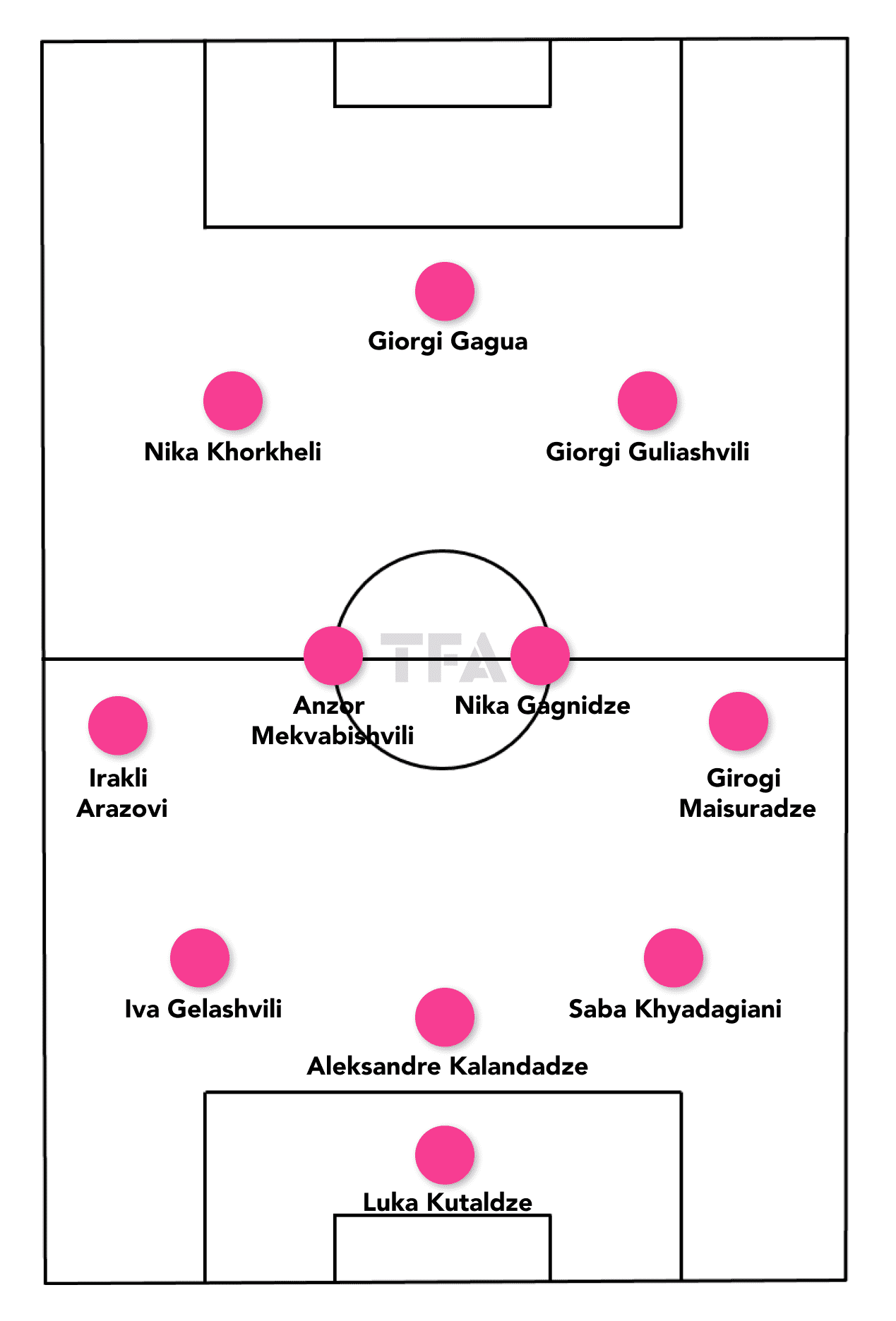
Nika Gaginidze has also featured relatively consistently in the midfield and has captained the side at points. Gagnidze, when deployed, has performed in a box-to-box role, capable of making deep runs from midfield into the attacking half, as well as supporting the back-three and providing them with a passing option if need be.
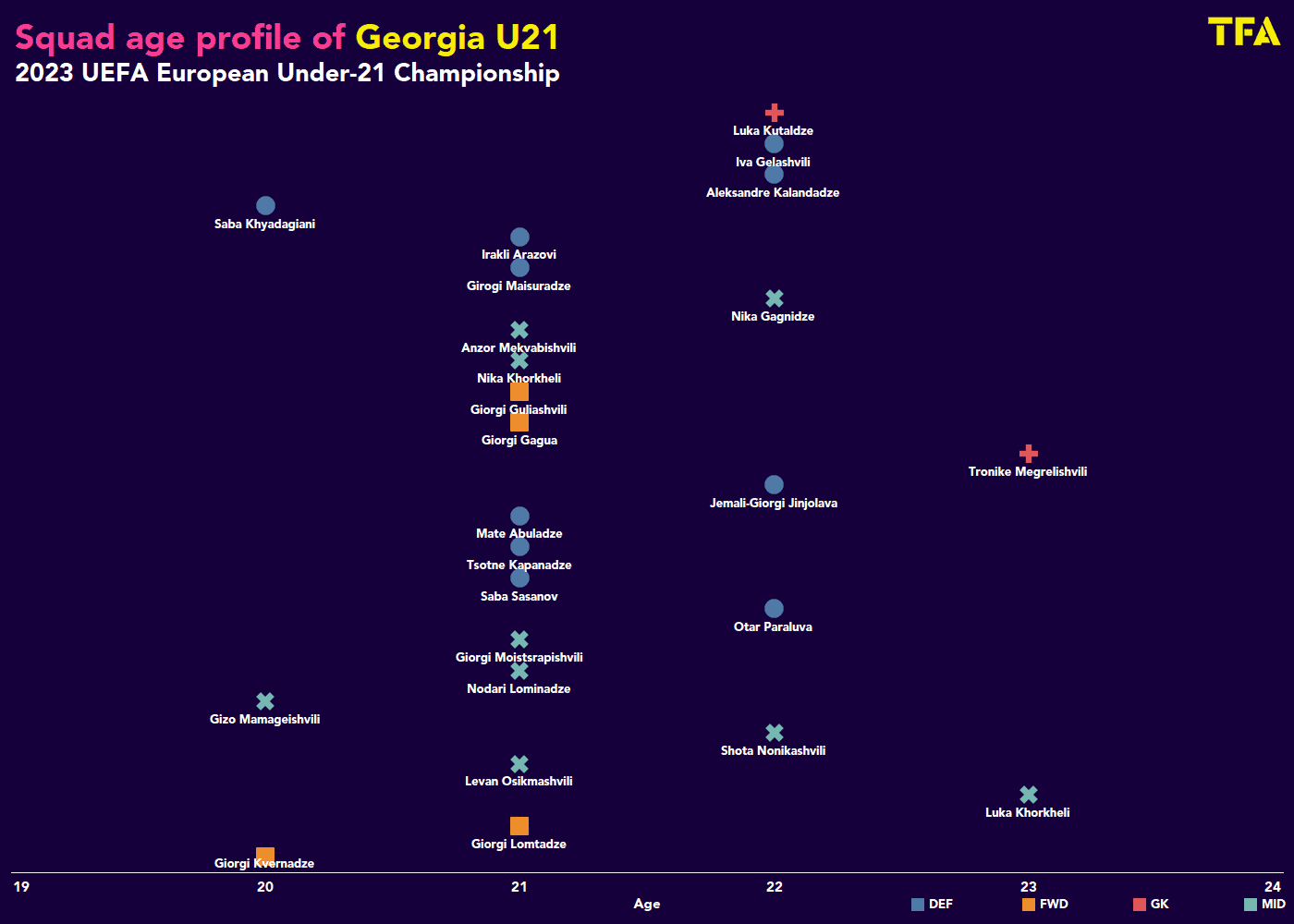
As far as Georgia’s squad profile it can be said that the squad somewhat lacks experience, with only two players in the squad over 23. Nevertheless, it can be stated that this tournament provides an opportunity for younger players to be exposed to an unfamiliar setting for them and gives them a chance to gain experience for future tournaments of this nature.
Attacking phase
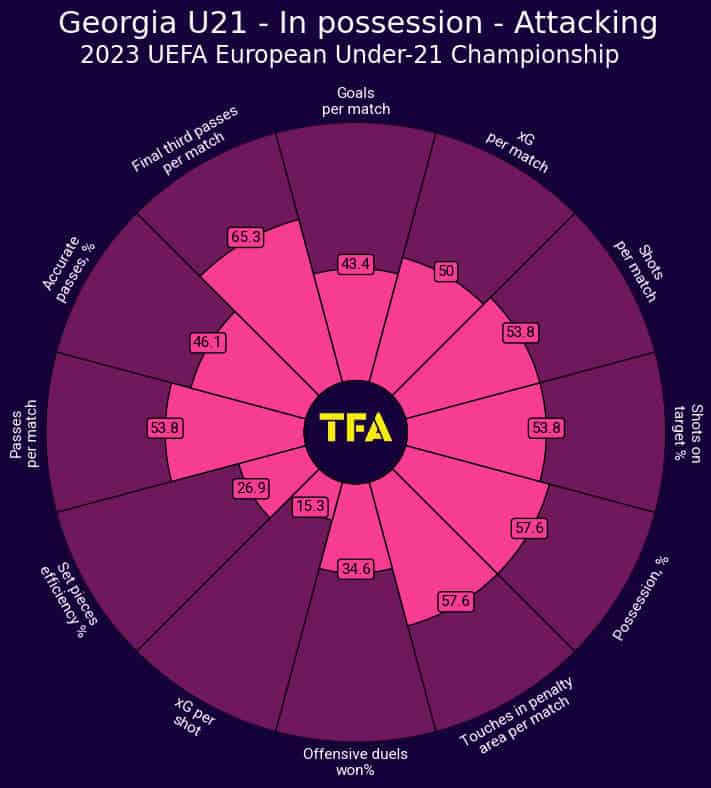
In the majority of their friendlies, Georgia have not been completely dominated by the opposition and have had spells where they enjoy relatively long periods of possession. However, as can be seen in the image above, they only rank in the 43rd percentile for goals per match and the 50th and 53rd percentile for xG and shots per match. In addition to this, their reliance on creating opportunities from wide areas has led to the side being in the 15th percentile for xG per shot.
Georgia generally look to play longer passes to their wing-backs in advanced wide areas, and as a result rank in the 65 percentile for passes into the final third but are only in the 46th percentile for the percentage of accurate passes.
As mentioned earlier, Georgia utilises a back-three when in possession. This back-three looks to circulate the ball until a pass to the wing-backs becomes available, with Georgia mainly looking to progress the ball down the channels. As a result of this, their wing-backs are very important in possession and are one of the strongest facets of this Georgia side in possession
Georgia’s structure in possession can be seen below. What starts off as a 3-4-2-1 on paper changes slightly to 5-2-2-1 with the central midfielders alternating in dropping deep in order to support the centre backs, with the other midfielder either holding their position or pushing further up the pitch.

The actions of their midfielders can be seen in more detail in the image below, with Anzor Mekvabishvili dropping deeper in order to give Kutaladze the goalkeeper a passing option.

Georgia look to play the ball to their wing-backs even when building up from deep in their own third, with either the goalkeeper or centre-backs playing lofted balls to the wing-backs out wide who will then look to advance quickly into the space ahead of them.
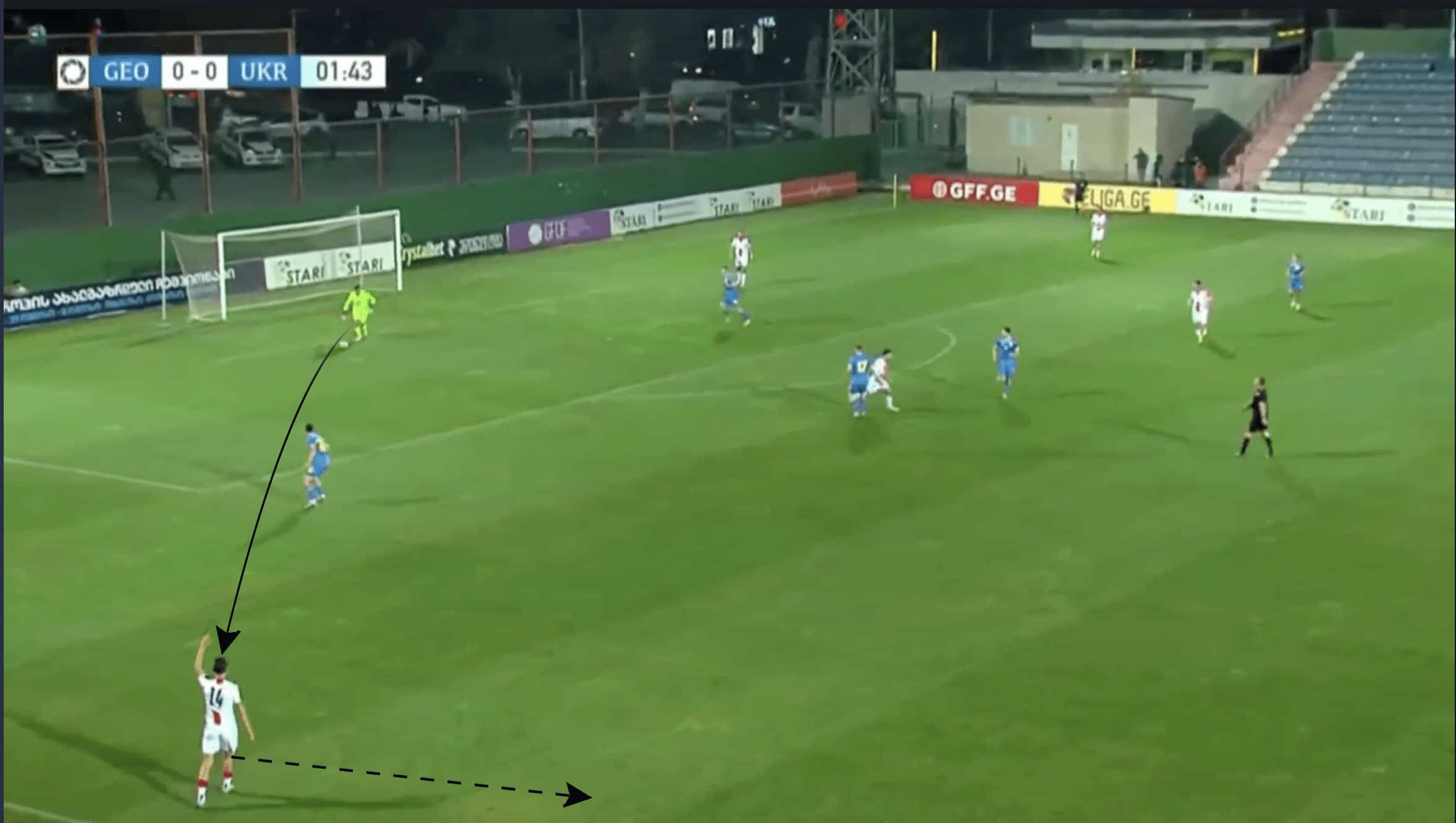
This is also the case in more advanced areas of the pitch, as can be seen below, with the left wing-back positioned in an advanced position on the touchline and thus receiving the ball from the centre-back.
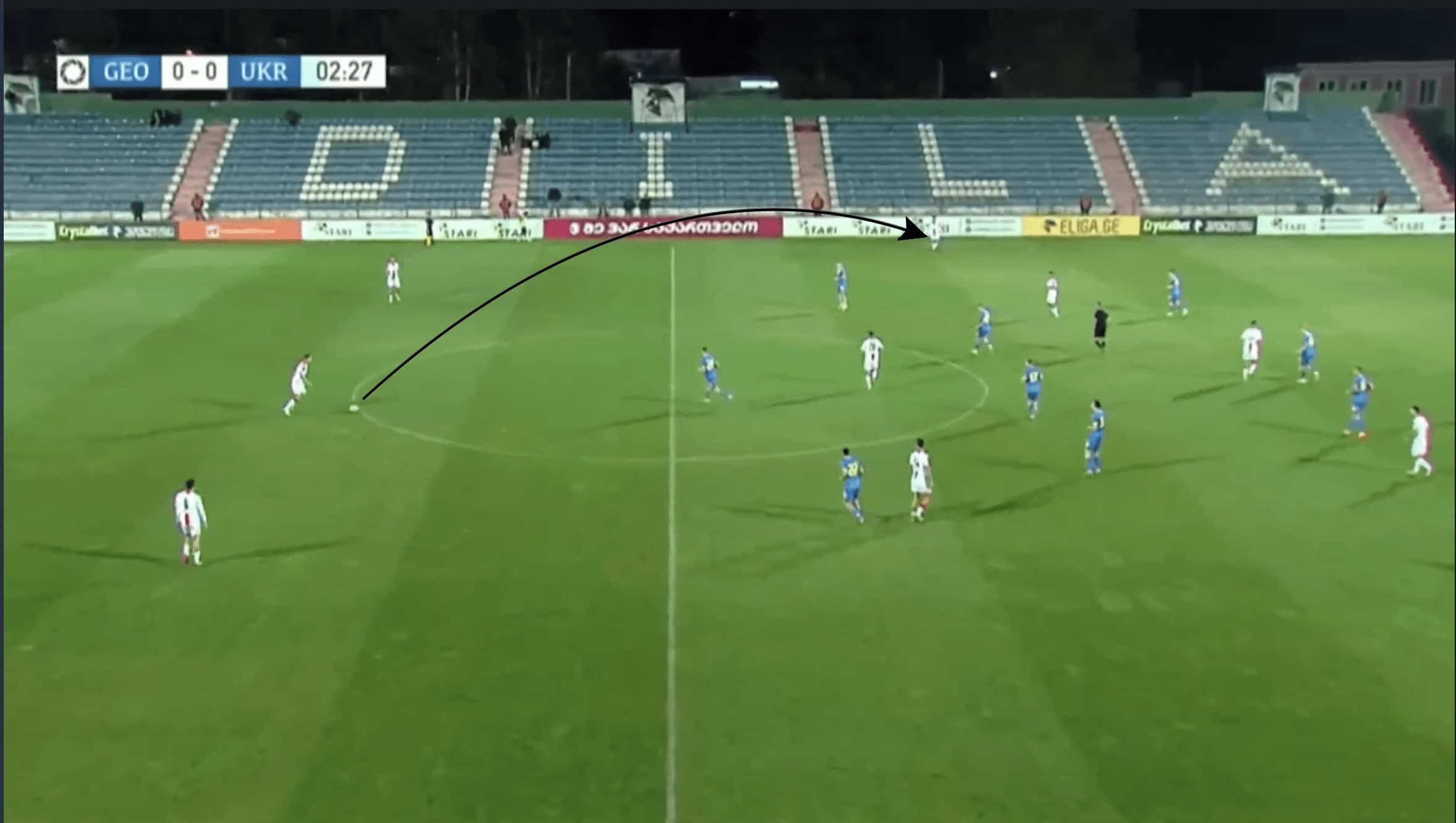
Georgia also look to overload the last line of opposition defence, with their two attacking midfielders advancing into the forward line and their wing-backs pushing as high as possible.
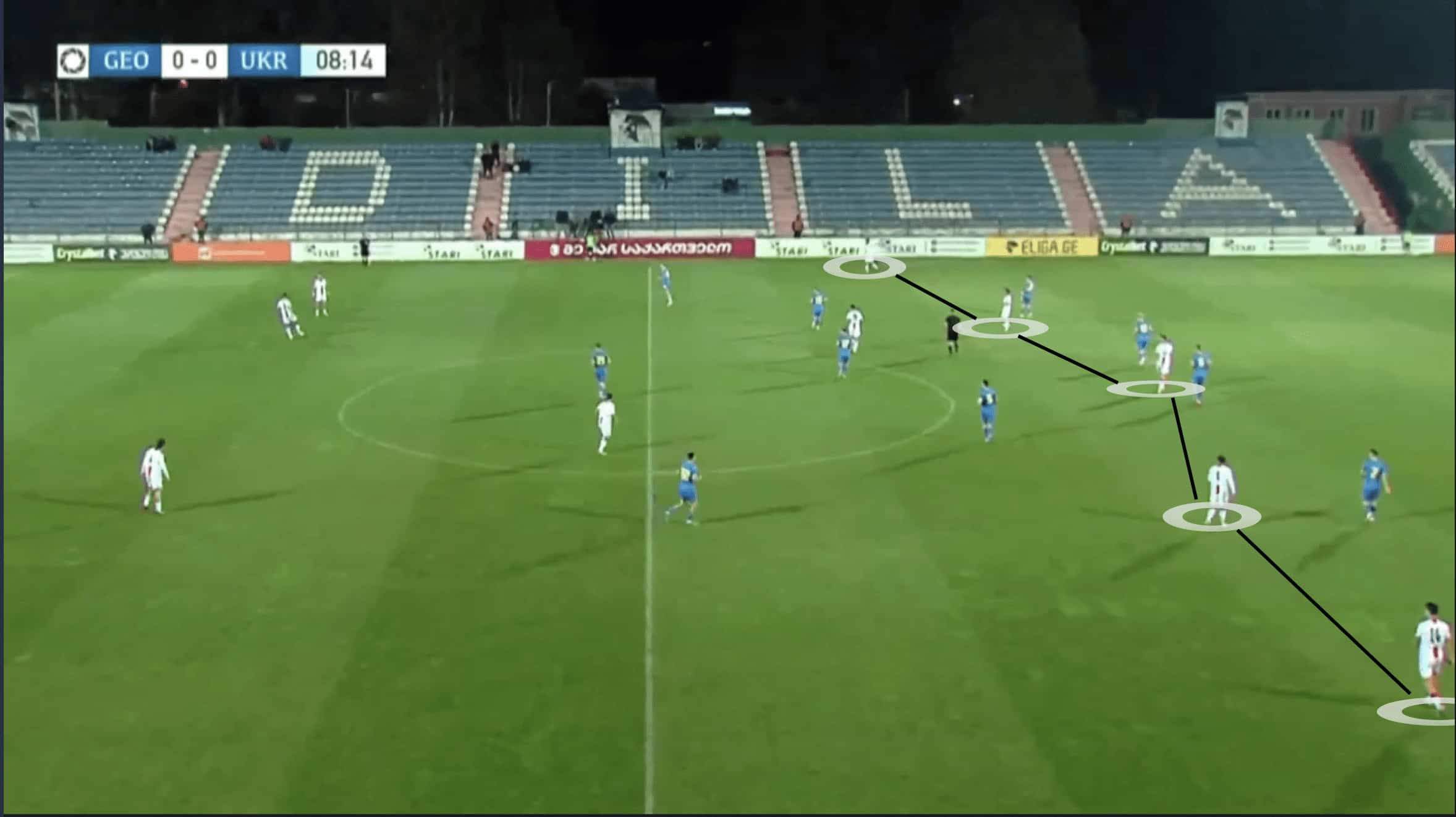
This ties into Georgia’s attacking actions in the final third. As seen in the image below, once the wingback receives the ball, the attacking midfielders Guliashvili, Nika Khorkheli, the central midfielder Gagnidze and the striker Gagua all look to make attacking runs into the box.
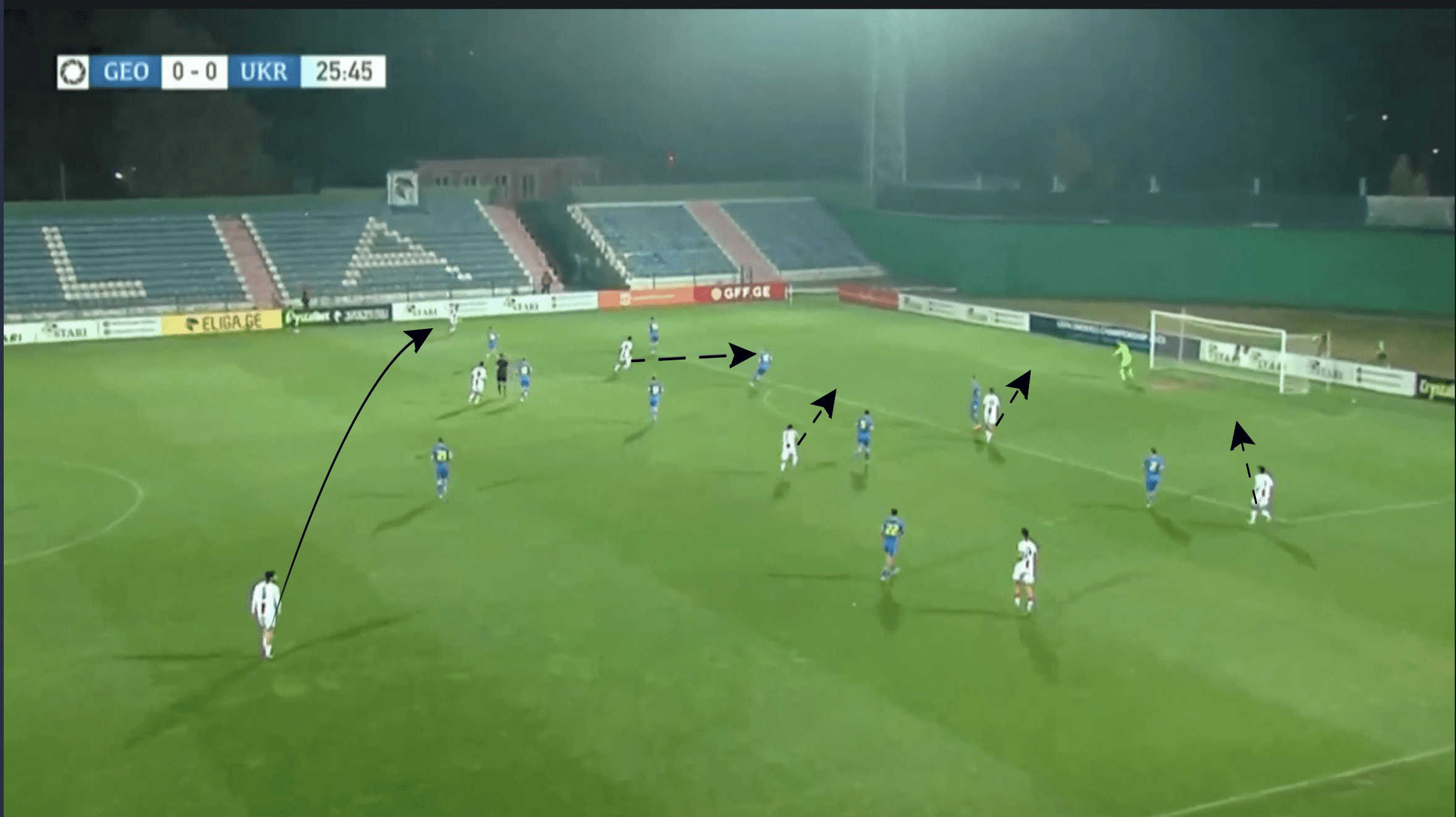
Defensive phase
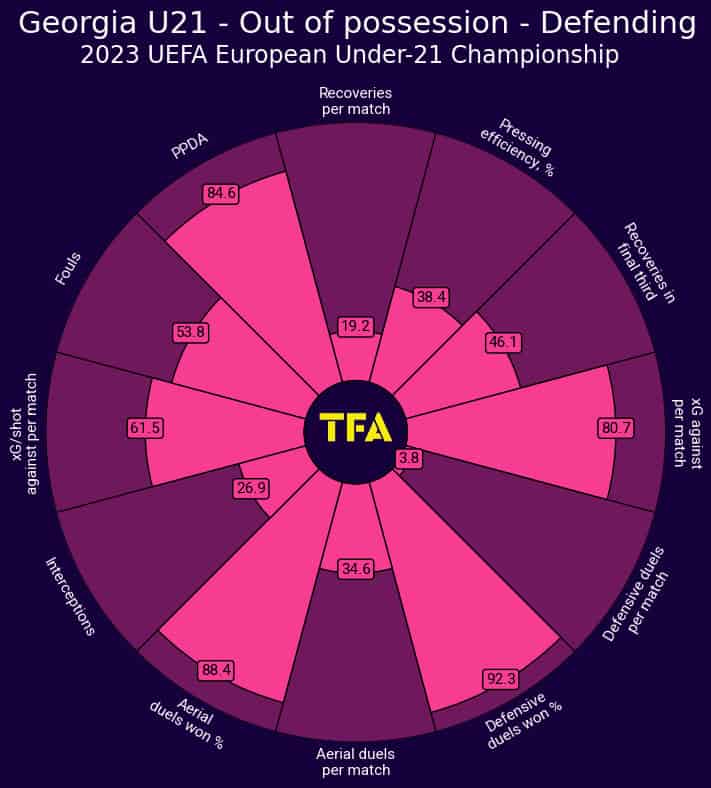
Defensively, in their friendlies preceding the tournament, Georgia have not typically looked to press their opposition aggressively in advanced areas of the pitch. This is reflected in their 84th percentile rank for PPDA — suggesting the non-aggressive nature of their press.
In addition to this, Georgia are also in the 80th percentile for xG against per match and the 61st percentile for xG per shot against.
When defending, Georgia’s structure can take on many shapes, due to the man-oriented nature of the side’s press. The main focus of their press is to prevent passes into the centre and force the opposition to the wide areas, where they look to take advantage of the touchline and can truly collapse on the opposition, with Georgia retrieving the ball most often from the wide areas.
In the example below, after Portugal’s centre-back plays a pass back to his goalkeeper, Georgia use this as an opportunity to advance further up the pitch. While doing so the striker, Guliashvili, applies pressure on the goalkeeper, whilst preventing a central pass to the other Portuguese centre-back, with the keeper playing pass out wide.
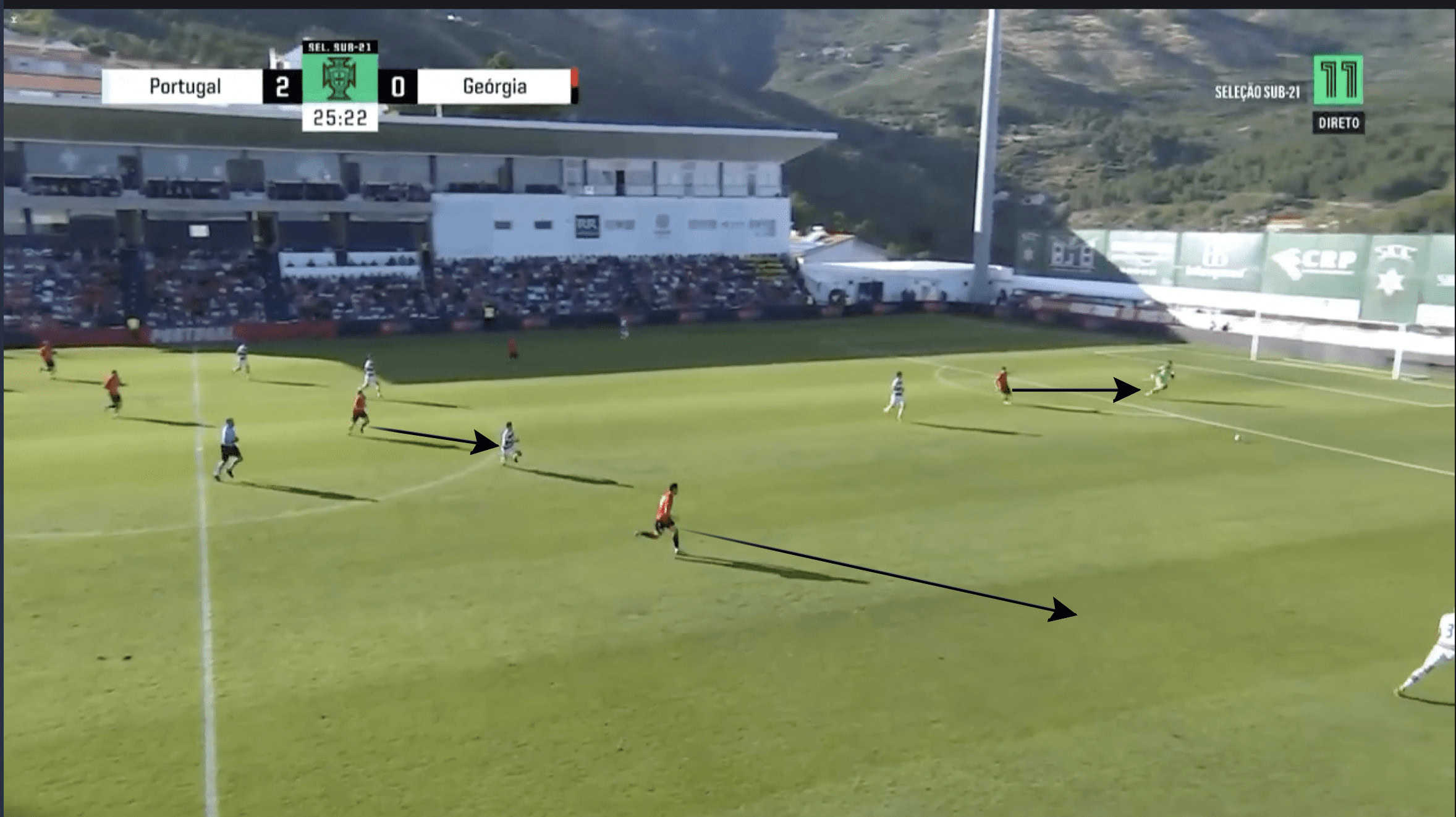
Moments later, We can see Guliashvili preventing passes to the centre-back and to the keeper, while his teammates orient their position to other Portugal players that are in positions to support the ball carrier.

In addition to this pressing strategy, the Strikers also look to arch their movements and split the centre backs in order to guide the opposition towards the wide areas. As can be seen in the example below, Gagua, the striker, presses the opposition defender at an angle to prevent a pass back to the goalkeeper or to the other centre-back. Guliashvili also does the same in order to retain the compactness of the structure.

Transitions
Due to their frequent pressing, Georgia often find themselves in positions where they are able to counter-attack after winning back the ball in wide areas. In these instances, players such as Guliashvili as well as their wing-backs, are able to advance further up the pitch with the majority of their wing-back options as well as Guliashvili fairly quick in transition.
However, in certain instances in transition, the players are guilty of holding on to the ball for slightly too long. This results in some missed opportunities to take advantage of spaces left by the opposition. This can be seen in the image below as after Gocholeisvili wins the ball and plays a pass to Luka Gagnidze, Gagnidze misses an opportunity to play a pass to Guliashvili running into space.
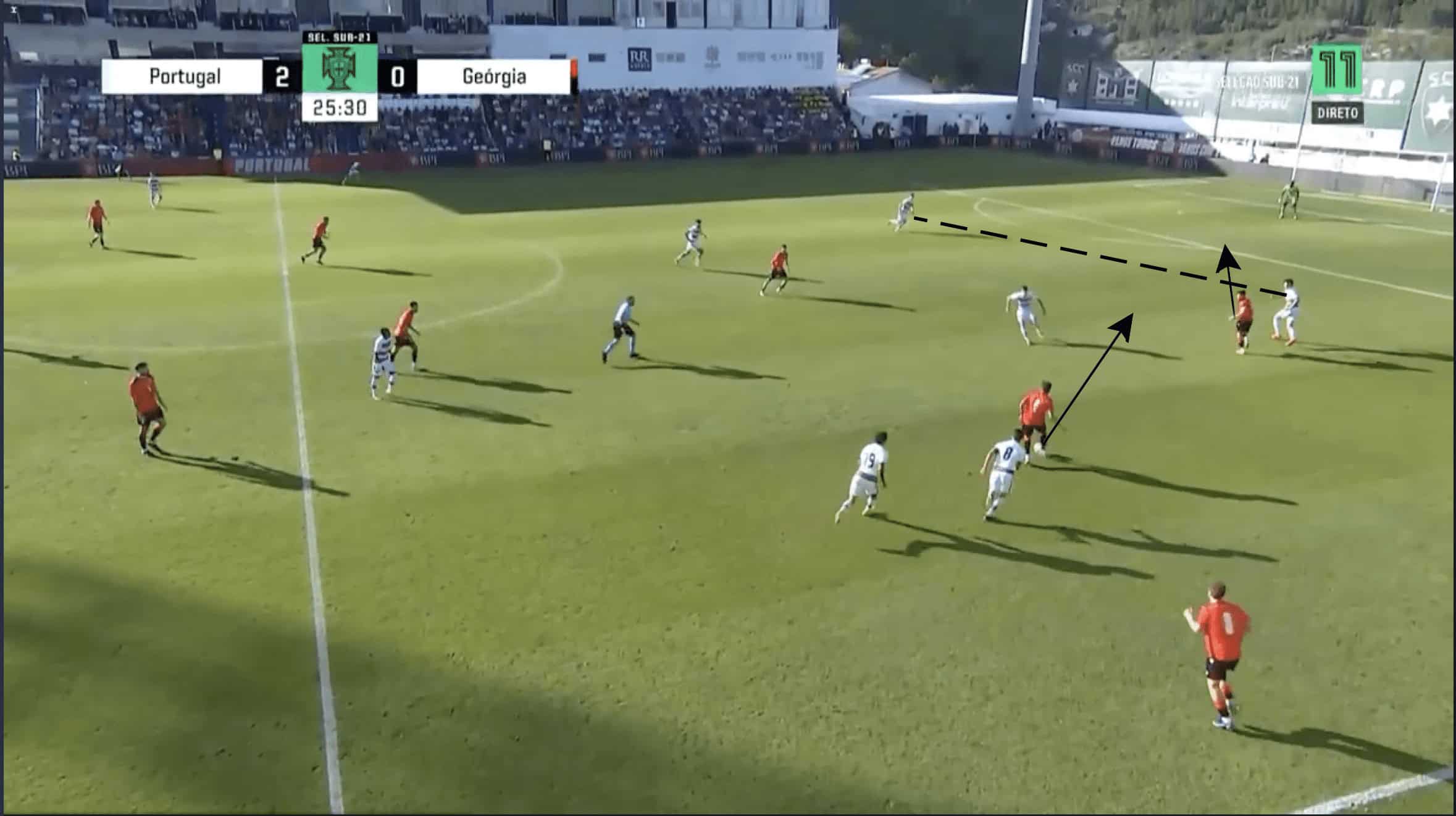
In their game against Ukraine, a similar scenario occurred. In this example, Georgia would once again win the ball out wide, with Guliashvili intercepting a pass and proceeding to advance into an attacking position. However, once again, from regaining possession out wide, Guliashvili failed to find the run of Gagua.

Defenders
In regards to their centre-backs, Georgia have a host of options to choose from. Regardless of this, it is likely that Kalanadze and Geliashvili will feature in the majority of their games in the group stages. Kutaladze is also likely to feature often, with the keeper adept with his feet and a reliable shot-stopper.
Georgia also have a host of wing-back options to call upon but unlike the centre-backs, it is unclear who will mainly feature in the starting XI.
Midfielders
The midfielders in this Georgia side have an important role to play, due to their responsibilities in both in the early stages of build-up as well as the final third. Several midfield partnerships have been deployed throughout Georgia’s international friendlies but Nika Gagnidze has featured the most often.
Regardless of the different variations in partnerships, Georgia’s midfielders have shown themselves to be capable of balancing their duties in the deeper build-up as well as supporting play in the final third.
Attackers
The attack is, perhaps, Georgia’s weakest area in relation to depth. Throughout their friendly games, Gagua, as well as Guliashvili, have led the line, usually playing with one another. If Georgia are truly to make their mark this tournament, they will require their attackers to be firing on all cylinders.
Key player
Georgi Gagua will have to be able to convert the chances that come his way if Georgia are to progress to the next stage.
These chances, however, may be few and far between due to the tough opposition that Georgia face in Group A. As can be seen in the image below, compared to other strikers in his age group, Gagua is not involved in a large amount of build-up play.
However, with the striker in the 46th percentile for goal contributions per 90 and the 66th percentile for touches in the penalty area, there are suggestions that this Georgia side will have to rely heavily on the striker in the box.
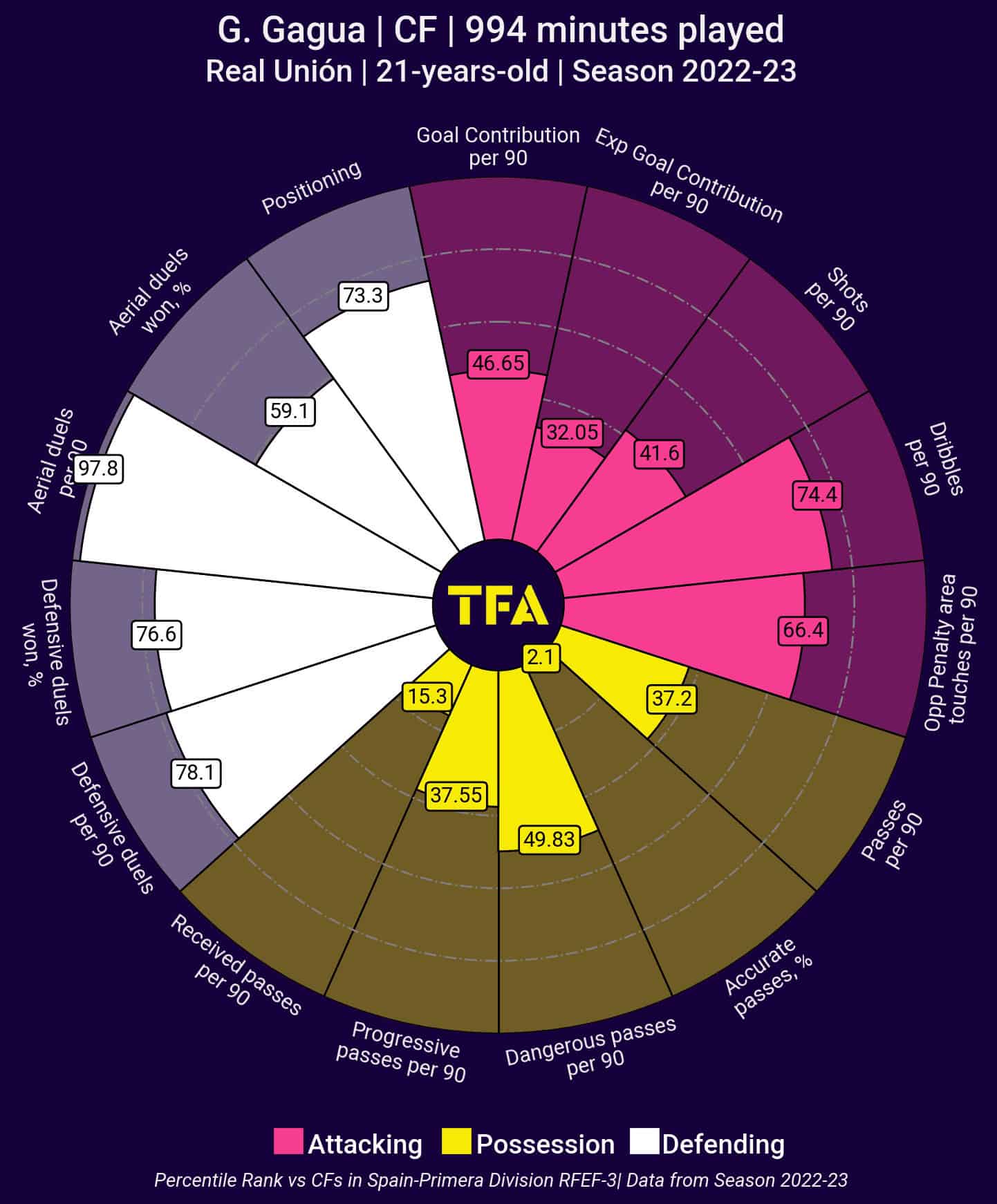
Conclusion
In their inaugural EURO U21 Championship, it is rather unfortunate that Georgia have been placed into one of the more difficult groups in the tournament. Despite this, Georgia still has a number of players capable of producing moments of magic. Georgia will need these players to show their ability early on and consistently, otherwise, it will be difficult for them to make it beyond the group stage.





Comments